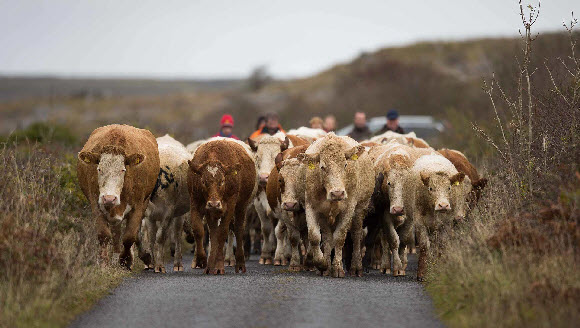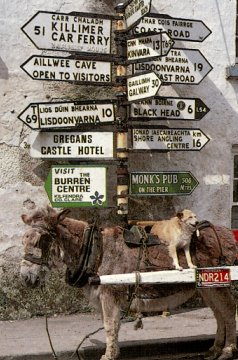Cultural heritage
Cultural heritage is often expressed as Intangible Cultural Heritage.
What is cultural heritage?
Cultural Heritage can be described as the legacy of both the physical artefacts and intangible attributes, values, and traditions of a group or society that are inherited from previous generations, maintained in the current generation, and preserved for future generations.
Cultural vitality is essential to a healthy and sustainable society. Oral history eventually becomes the living heritage, which is being effectively captured in recording past memories from older people. Clare County Council also recognises the importance of linguistic heritage to the people and culture of the County. In addition, genealogy is an important educational and leisure activity and many tourists have developed a keen interest in sourcing information on their ancestors and family roots.
Ireland’s national inventory of intangible cultural heritage
In 2019, Winterage in the Burren, practices at Clare’s Holy Wells and traditional sea currach making were given official recognition by Minister for Culture, Heritage and the Gaeltacht Josepha Madigan TD at the launch the permanent National Inventory of Intangible Cultural Heritage. The development of the National Inventory of Ireland’s Intangible Cultural Heritage is an integral part of the Department’s work under the 2003 UNESCO Convention for the Safeguarding of the Intangible Cultural Heritage, which requires signatory States to recognise, protect and promote the living cultural heritage of their countries. The Fair of Spancill Hill, Ireland’s oldest horse fair, was the most recent addition to the National Inventory of Ireland’s Intangible Cultural Heritage.

The Holy Wells Project involves a countywide survey by Michael Houlihan and Tony Kirby working with the Heritage Officer of Clare County Council. There are 241 Holy Wells listed in the Record of Monuments and Places for County Clare. Some are well known and currently have well established pattern days. These records are uploaded to the iCAN Clare County Community Heritage Network website to raise awareness among the public about their local Holy Wells.

The Burren Winterage refers to a unique farming tradition that has been practiced in the Burren for thousands of years. For thousands of years, Burren farmers have marked the end of summer by herding their cattle onto ‘winterage’ pastures in the limestone uplands where they spend the winter grazing. This ancient reverse ‘transhumance’ tradition is synonymous with the Burren and is key to the survival of the region’s famous flora and fauna. The Burren is an agricultural landscape rich in ancient field monuments which are uncommonly well preserved. The Burren contains over 70% of Ireland’s native flora and is host to a mosaic of significant habitats which have been formed and sustained through human interaction with the karst terrain. The Burren and its distinctive limestone landscape are a source of great inspiration for intangible heritage resulting in a rich cultural legacy as shown by the people through art, music and literature.

The West Clare Currach Club is an umbrella Club for a growing number of rowing clubs based along the coastline of County Clare. The club represents the sport of currach rowing in the region and promotes the participation for all at both recreational and competitive level. County Clare has three distinctive waterbodies; the Atlantic Ocean, estuaries and inland waterways, all of which have influenced the type of traditional boats used in each area. Heritage boats are useful for keeping alive the tradition of fishing techniques, knowledge of the local sea and the oral tradition. This was borne out when Clare County Council delivered a countywide survey of Clare Traditional Boats and Currachs.
Cultural heritage in Clare
County Clare has long been recognised for its richness of cultural heritage, from traditional music, Gaelic games and vibrant folk heritage. Creative Ireland Clare aims “to ensure the people of Clare discover and have access to cultural expression through creative activity”. The priorities of the programme include the creation of opportunities to access innovative culture-based programmes, developing the county’s creative capacity and reputation and working collaboratively to develop cultural expression and wellbeing. See below just some examples of positive developments for our cultural heritage in Clare, supported by the Clare County Council:
- Clare Arts Office
- Clare County Library
- Clare placenames
- Clare Roots Society
- Cuimhneamh an Chláir
- Ireland Reaching Out
- Killaloe-Ballina Local History Society
- Kilrush and District Historical Society (KDHS)
Clare Arts Office
Clare Arts Office is a service of Clare County Council located within the Social Development Directorate of the Local Authority. The overarching vision for the Social Directorate is that: Clare will be a regional/national centre of culture, sport, arts, heritage, business and built environment ensuring Clare is a preferred international destination for investment and innovation where the people and businesses of Clare are supported by the Council.
Clare County Library
The Clare County Library website has comprehensive sections on history, heritage, placenames and genealogy. It is the principal one-stop-shop for Clare genealogy data including baptisms, tithe applotments, Griffith's Valuation, censuses, maps, historical texts, parish histories etc.
Clare placenames

Our placenames help us to read out landscape and to understand our place. They are an important part of our geographical and cultural environment and enable us to identify geographical entities and represent unique cultural values and insights.
Under a previous Clare Heritage Plans, Clare County Council and the Heritage Council established a structure for recording Clare Placenames information found within the townlands of county Clare. A townland is the smallest geographical unit in Ireland. According to the maps of the Ordinance Survey, there are 2176 townlands in Clare, each providing a rich resource of placenames information. The development of the Clare Placenames Project saw several townland studies conducted by volunteers across the county. Comprehensive research has been conducted into existing studies and information collected to date can be viewed on the Clare townland fieldname survey.
For further information on Placenames:
- Clare Places and Placenames (clarelibrary.ie)
- Cork and Kerry Placenames
- Galway Placenames
- Placenames Commission of Ireland
Clare Roots Society
In recent years, the exploration of family history as well as community research and oral history have seen tremendous engagement from local communities, with some exciting projects developing in Clare.
The Clare Roots Society is a group which studies family history, genealogy and heritage of County Clare, Ireland and generates Clare genealogy data for free use. It was formed in April 2006 as an amateur history, genealogy and heritage group in County Clare.
Cuimhneamh an Chláir (Clare Memories)
Cuimhneamh an Chláir (Memories of Clare) is an independent, not for profit, community-based organization that aims to record, document, archive and store the memories, experiences, customs, traditions and practices that characterise County Clare. Nationally, the Oral History Network of Ireland, offers an important resource for oral history.
Ireland Reaching Out
The Ireland Reaching Out Project is an Irish government sponsored project enabling local Irish parish-based communities to reach out and engage and identify with their diaspora worldwide while also tracing their family roots. The aim of the project is to connect people of Irish heritage abroad with the Irish parish communities from which their ancestors emigrated.
Killaloe-Ballina Local History Society
Killaloe-Ballina Local History Society began with an informal community meeting in our local library, on 23rd August 2017. The society operate a comprehensive programme, from public lectures to oral history, the publication of an annual journal as well as a comprehensive and engaging website.
Kilrush and District Historical Society (KDHS)
In 2020, as part of the Historic Towns Initiative, Clare County Council completed the conversion and restoration of Turret Lodge in Kilrush, turning it into a community-run Heritage and Genealogy Centre. The members of KDHS will operate a new genealogy and exhibition space. You can watch a presentation on the project on YouTube. In 2021, the project was announced as the Preservation and Conservation Award Winner by the Chartered Association of Building Engineers (CABE). You can watch a short promo video also on YouTube
Cultural heritage legislation & best practice guidance

Cultural heritage is a broad concept. Therefore, the legislation surrounding its preservation is wide-ranging. In December 2015, Ireland ratified the UNESCO 2003 Convention for the Safeguarding of the Intangible Cultural Heritage (ICH), which aims to safeguard, appreciate, and raise awareness of intangible cultural heritage while also providing for international cooperation and assistance in this area. To date, Ireland has also been successful in having three elements of our living heritage inscribed on the UNESCO Representative List of the Intangible Cultural Heritage of Humanity; Uilleann Piping in 2017, Hurling in 2018 and Irish Harping. Some significant pieces of legislation also include:
While the Department of Housing, Local Government and Heritage has responsibility for the protection of our Heritage, the Department of Tourism, Culture, Arts, Gaeltacht, Sports and Media, has a more direct role in the protection and promotion of Irish culture. More information can be found on gov.ie website.
Page last reviewed: 10/03/22
Content managed by: Heritage unit (within Planning department)
Back to topContact
Áras Contae an Chláir
New Road
Ennis
Co. Clare
V95 DXP2
(065) 684 6407
This is just for feedback on our web site, not comments or questions about our services.
To tell us about anything else, go to our contact us pages.
